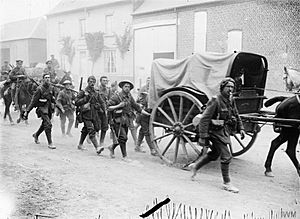Daniel Burges facts for kids
Quick facts for kids
Daniel Burges
|
|
|---|---|
 |
|
| Born | 1 July 1873 London, England |
| Died | 24 October 1946 (aged 73) Bristol, Gloucestershire |
| Buried |
Arnos Vale Cemetery, Bristol
|
| Allegiance | |
| Service/ |
|
| Years of service | 1893–1923 |
| Rank | Lieutenant Colonel |
| Unit | Gloucestershire Regiment |
| Commands held | 10th (Service) Battalion, East Yorkshire Regiment 7th Battalion, South Wales Borderers |
| Battles/wars | Second Boer War First World War |
| Awards | |
Lieutenant Colonel Daniel Burges (born 1 July 1873 – died 24 October 1946) was a brave English soldier. He received the Victoria Cross (VC) and the Distinguished Service Order (DSO). The Victoria Cross is the highest award for bravery in the face of the enemy. It is given to soldiers from Britain and the Commonwealth.
Contents
A Young Soldier's Journey
Daniel Burges went to Winchester College for his education. He joined the Gloucestershire Regiment as a second lieutenant in 1893. He quickly moved up the ranks. In 1897, he became a lieutenant.
Fighting in South Africa
When the Second Boer War started in 1899, Burges went to South Africa. He was part of the 2nd battalion of his regiment. He took part in many important battles. These included the Relief of Kimberley. He also fought in the Orange Free State and Transvaal. For his courage, he received two special medals. These were the Queen's South Africa Medal and the King's South Africa Medal. He stayed in South Africa until the war ended in 1902.
World War I Service
Burges became a captain in 1903. Before World War I, he worked with the Punjab Volunteer Rifles. When World War I began, he served with his regiment again. He fought in the Second Battle of Ypres and was wounded. After he recovered, he became a temporary Lieutenant-Colonel. He commanded the 10th (Service) Battalion. This unit was also known as the 'Hull Commercials'.

His battalion trained hard for battle. They went to Egypt first. There, they guarded the Suez Canal. Later, they moved to the Western Front in Europe. They spent weeks holding trenches. They also did patrols and raids.
The Battle of the Somme
The 10th Battalion was part of the first day of the Battle of the Somme. This huge battle began on 1 July 1916. Before the main attack, the battalion held the front lines. They faced heavy German shelling. Many soldiers were killed or wounded. Lieutenant-Colonel Burges left his command on 30 June. He then became an instructor at a school for senior officers. In 1917, he took command of the 7th Battalion. This unit was part of the South Wales Borderers. He led them at the Salonika front.
Victoria Cross Award
Daniel Burges was 45 years old when he earned the Victoria Cross. He was a temporary lieutenant-colonel. He was commanding the 7th (Service) Battalion. This happened during the First World War at the Battle of Doiran.
Here is what happened:
On 18 September 1918 at Jumeaux, in the Balkans, valuable reconnaissance of the enemy front line trenches enabled Lieutenant Colonel Burges to bring his battalion, without casualties, to the assembly point, but later while some distance from the objective they came under severe machine-gun fire. Although he himself was wounded the colonel continued to lead his men with skill and courage until he was hit again twice and fell unconscious. He was taken prisoner by the Bulgarians, but was abandoned in a dug-out with one of his legs shattered.
This means he bravely led his soldiers. He got them safely to their starting point. But then, they faced heavy machine-gun fire. Even though he was wounded, he kept leading his men. He was hit two more times and passed out. The enemy captured him. However, they later left him behind in a dugout. He had a badly injured leg.
Life After the War
After retiring from the army, Burges had another important role. He served as the Resident Governor of the Tower of London. He held this position from 1923 to 1933. Later, he moved to Durdham Down near Bristol. From 1943 to 1945, he directed the British Red Cross in his county.
A special marble plaque was put up for him. It is at Arnos Vale Cemetery in Bristol. This happened on 24 October 2006. This date was exactly 60 years after he passed away.

